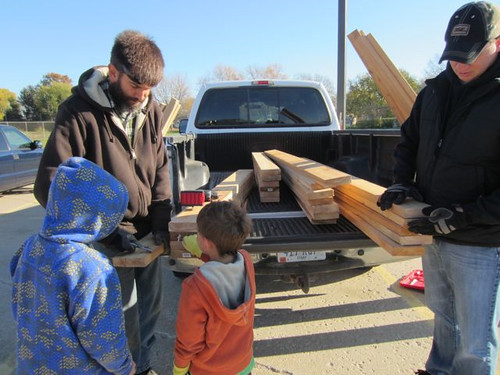
Agricultural research science technician Fred Engstrom (left), a parent volunteer and two Central Elementary students measure out lumber for building raised beds at Noah’s Garden.
As an agricultural research science technician at the Agricultural Research Service’s (ARS) North Central Regional Plant Introduction Station in Ames, Iowa, Fred Engstrom’s responsibilities are wide-ranging. They include tasks from managing the station’s nursery and field plots to modifying research equipment and collecting yield data for critical projects such as the Germplasm Enhancement of Maize program.
But the ARS station isn’t the only beneficiary of Engstrom’s versatile contributions. His time and technical know-how have also been praised by members of Central Elementary in Nevada, Iowa, where Engstrom helped to build the raised beds and irrigation system for the school’s community garden, dubbed “Noah’s Garden.”
The school began the project in 2012 to provide over 350 students from 16 classrooms with a hands-on opportunity to grow their own food while simultaneously incorporating concepts in math, science, language and other academic fields. The students, together with their teachers and parents or guardians, participate in the Noah’s Garden project from seeding to harvest. What the families don’t take home—which can include tomatoes, lettuce, beets, broccoli, peppers, sweet corn, carrots, string beans, and other produce—is donated to local food-distribution centers.
“Fred Engstrom has been an active supporter of our garden from the beginning,” says Jamie Hughet, a Central Elementary teacher and project organizer. “He was instrumental in preparing the garden and materials of the initial eight 4- by 8-foot beds and the wood-chip paths. He investigated a proper soil mixture for our area and designed the irrigation system.” In 2014, he helped add 10 more beds, expanding the garden area to 35- by 45-feet, she added.
The students are assigned one raised bed per class and get to choose what they want to plant. Some have done theme gardens, including pizza and salsa gardens, as well as flower gardens displaying Iowa State University colors. Throughout, says Hughet, the students record and chart seed growth, conduct germination trials and keep weekly plant-observation journals.
Engstrom is modest about his contributions to Noah’s Garden, but it’s clear he’s gotten as much out of the project as he has given working as a parent volunteer with the students and their families.
“I feel it’s beneficial for our kids to reconnect to the land in a dirty-hands kind of way,” he says. “I also find having parents involved working with other parents and children creates a good example for the children to see and hopefully emulate.”
No comments:
Post a Comment
Note: Only a member of this blog may post a comment.